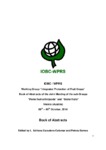Use este identificador para citar ou linkar para este item:
http://www.alice.cnptia.embrapa.br/alice/handle/doc/999356Registro completo de metadados
| Campo DC | Valor | Idioma |
|---|---|---|
| dc.contributor.author | KOVALESKI, A. | pt_BR |
| dc.contributor.author | CARBONARI, J. J. | pt_BR |
| dc.contributor.author | FOLLE, A. D. | pt_BR |
| dc.date.accessioned | 2014-11-06T11:11:11Z | pt_BR |
| dc.date.available | 2014-11-06T11:11:11Z | pt_BR |
| dc.date.created | 2014-11-06 | pt_BR |
| dc.date.issued | 2014 | pt_BR |
| dc.identifier.citation | In: IOBC-WPRS WORKING GROUP "INTEGRATED PLANT PROTECTION IN FRUIT CROPS", SUB GROUPS "POME FRUIT ARTHROPODS" AND "STONE FRUITS", 2014, Vienna. Abstracts... Vienna: IOBC-WPRS, 2014. | pt_BR |
| dc.identifier.uri | http://www.alice.cnptia.embrapa.br/alice/handle/doc/999356 | pt_BR |
| dc.description | Cydia pomonella is the most important apple and pear pest in the main producing areas of the world. In Brazil, C. pomonella was detected for the first time in 1991, and the specimen captured was identified by Dr. Vitor Becker. With the detection of this specimen in the urban area of Vacaria ? RS, Brazil, the monitoring was intensified in all the Brazilian temperate fruit producing region. The monitoring included urban and commercial areas in the producing region, as well as urban areas in the route of apple transport from Argentina and Chile into Brazil. Traps were also installed in the CEASAS of the Southern Region in Brazil. The first year of full monitoring was in the 1997/98 season, when around 22,500 males were captured in the urban areas of Bom Jesus, Caxias do Sul, and Vacaria, in the state of Rio Grande do Sul, and in Lages (Santa Catarina). Considering the severity of the infestation, a National Committee was created, composed of representatives from governmental agencies and grower associations, defining the population suppression program through the installation of panels with insecticide and sexual pheromones (i.e. attract-and-kill system). Due to the costs and delay in the registration of the attract-and-kill system, the suppression program was suspended. In July of 2002, the Committee decided for the eradication of the host plants in the infested urban areas, with the removal directed to the points of greater population density. During the eradication program, around 95,000 host plants were removed and replaced with non-host plants. With the removal of hosts, there was a decline in the captures, culminating with the capture of the last C. pomonella in Brazil in November of 2011. Based on the results of the program, on 5 May 2014, the Ministry of Agriculture, Livestock and Food Supply officially declared the eradication of C. pomonella in Brazil. This was registered through the Normative Instruction no. 10, | pt_BR |
| dc.language.iso | eng | eng |
| dc.rights | openAccess | eng |
| dc.title | Cydia pomonella, the first eradicated pest in Brazil. | pt_BR |
| dc.type | Resumo em anais e proceedings | pt_BR |
| dc.date.updated | 2014-11-06T11:11:11Z | pt_BR |
| dc.subject.thesagro | Maçã | pt_BR |
| dc.subject.thesagro | Pera | pt_BR |
| dc.subject.thesagro | Fruticultura | pt_BR |
| dc.subject.thesagro | Controle integrado | pt_BR |
| dc.subject.thesagro | Praga de planta | pt_BR |
| dc.subject.thesagro | Cydia Pomonella | pt_BR |
| dc.subject.thesagro | Erradicação | pt_BR |
| dc.format.extent2 | p. 45 | pt_BR |
| riaa.ainfo.id | 999356 | pt_BR |
| riaa.ainfo.lastupdate | 2014-11-06 | pt_BR |
| dc.contributor.institution | ADALECIO KOVALESKI, CNPUV. | pt_BR |
| Aparece nas coleções: | Resumo em anais de congresso (CNPUV)  | |
Arquivos associados a este item:
| Arquivo | Descrição | Tamanho | Formato | |
|---|---|---|---|---|
| Kovaleski2Capa.pdf | 59,12 kB | Adobe PDF |  Visualizar/Abrir |









